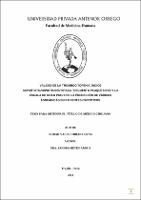Validez de la trombocitopenia, indice aspartatominotransferasa/recuento plaquetario y la escala de Child Pugh en la predicción de varices esofágicas en pacientes cirróticos

View/
Download
(application/pdf: 907.1Kb)
(application/pdf: 907.1Kb)
Date
2018Author(s)
Cobian Cerna, Norah Valia
Metadata
Show full item recordAbstract
OBJETIVO: Determinar el área bajo curva de la trombocitopenia, el índice
aspartatoaminotransferasa/ recuento plaquetario, y la escala de Child Pugh en
la predicción de várices esofágicas en pacientes cirróticos.
MATERIAL Y MÉTODOS: Se realizó un estudio de prueba diagnóstica en 113
pacientes diagnosticados con cirrosis hepática en el Hospital Victor Lazarte
Echegaray durante el periodo enero – diciembre 2017. Se calculó la
sensibilidad, especificidad, valores predictivos; así como los puntos de corte de
dichas pruebas. Se aplicó el Área bajo la curva y el test de Chi cuadrado.
RESULTADOS: De los 113 pacientes incluidos en el estudio, la frecuencia de
varices esofágicas en pacientes cirróticos fue de 73 (65%) y aquellos que no
presentaron varices fue de 40 (35%). El punto de corte de la Trombocitopenia
como predictor de varices esofágicas en pacientes cirróticos fue < 150000; con
una sensibilidad, especificidad, valor predictivo positivo y negativo de 69.86%,
32.5%, 65.38%, 37.14% respectivamente, también se evaluó como predictor la
Escala de Child Pugh, teniendo como puntos de corte para los grados B y C ≥
7 puntos; con una sensibilidad, especificidad, valor predictivo positivo y
negativo de 46.58%, 80%, 80.95%, 45.07% respectivamente. Por último se
halló el Índice aspartatoaminotransferasa / recuento plaquetario, con punto de
corte ≥ 0.039%, con una sensibilidad, especificidad, valor predictivo positivo y
negativo de 76.71%, 52.5%, 74.67%, 55.26% respectivamente. Al evaluar se
concluyó que las tres pruebas diagnósticas son estadísticamente significativas
(p<0.05) como predictores de varices esofágicas, no existiendo significancia
estadística entre ellas al compararlas (p=0.73).
CONCLUSIÓN: La Trombocitopenia, el índice Aspartatoaminotransferasa /
recuento plaquetario y la Escala de Child Pugh poseen validez como
predictores de varices esofágicas en pacientes cirróticos. OBJECTIVE: To determine the area under the curve of Thrombocytopenia, the
aspartate aminotransferase index/platelet count, and the Child Pugh scale in
predicting esophageal varices in cirrhotic patients.
MATERIAL AND METHODS: A diagnostic test study was conducted in 113
patients diagnosed with hepatic cirrhosis at the Victor Lazarte Echegaray
Hospital during the period January – December 2017. Sensitivity, specificity,
predictive values were calculated; as well as the cutting points of such tests.
The area was applied under the curve, the Chi -square test and the positive and
negative likelihood ratio.
RESULTS: Of the 113 patients included in the study, the frequency of
esophageal varicose veins in cirrhotic patients was 73 (65%) and those who did
not present varicose veins were 40 (35%). The cutoff point of thrombocytopenia
as a predictor of esophageal varicose veins in cirrhotic patients was < 150000;
With a sensitivity, specificity, positive and negative predictive value of 69.86%,
32.5%, 65.38%, 37.14% respectively, the scale of Child Pugh was also
evaluated as a predictor, having as cutting points for B and C ≥ 7; With a
sensitivity, specificity, positive and negative predictive value of 46.58%, 80%,
80.95%, 45.07%, respectively. Finally, the aspartate aminotransferase
index/Platelet count was found, with a cut-off point ≥ 0039%, with a sensitivity,
specificity, positive and negative predictive value of 76.71%, 52.5%, 74.67%,
55.26% respectively. In evaluating the diagnostic tests it was concluded that
each one presents statistical significance (p < 0.05), and that within them, the
scale of Child Pugh is the most statistically significant (P = 0.003%)
CONCLUSION: Thrombocytopenia, the aspartate aminotransferase
index/platelet count and the Child Pugh scale have validity as predictors of
esophageal varicose veins in cirrhotic patients.
Subject
Collections
- Medicina Humana [2969]

